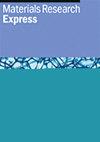Characterization of wood plastic composites made with recycled waste tire rubber
IF 2.2
4区 材料科学
Q3 MATERIALS SCIENCE, MULTIDISCIPLINARY
引用次数: 0
Abstract
Green materials are currently demanded for construction as well as other products since the 26th UN Climate Change Conference of the Parties (COP26) in 2021. Using renewable and sustainable resources to innovate new materials such as composites is encouraged. This study aimed to investigate the physical and mechanical characteristics of wood plastic composites (WPCs) when adding waste tire rubber as filler for 10% or 20% by weight. The results showed that the density of the WPC samples (50 wt% wood − 50 wt% high density polyethylene) increased with the addition of the waste tire rubber (WTR) while the dimensional stability of samples was reduced. The mechanical properties of the WPC samples were determined, including flexural strength, flexural modulus, elongation at break, tensile strength, tensile modulus, and impact strength. The WTR as filler in the WPC tended to decrease the tensile strength and flexural strength whereas it improved the impact strength of materials. The results indicated that the WTR as recycled material in WPC affected the physical and mechanical properties of the WPCs. Although the use of the WTR in the production of the WPC adversely affects the mechanical properties, the use of 10 wt% WTR was acceptable. The results of the study showed that the addition of the WTR to the WPC production process can be useful for its recycling and for reducing the cost of the WPC.用回收废轮胎橡胶制成的木塑复合材料的特性分析
自 2021 年第 26 届联合国气候变化缔约方大会(COP26)以来,建筑和其他产品目前都需要绿色材料。利用可再生和可持续资源创新复合材料等新材料的做法受到鼓励。本研究旨在调查木塑复合材料(WPCs)中添加 10%或 20%(重量百分比)废轮胎橡胶作为填料时的物理和机械特性。结果表明,添加废轮胎橡胶(WTR)后,木塑复合材料样品(50 wt% 木材 - 50 wt% 高密度聚乙烯)的密度增加,而样品的尺寸稳定性降低。测定了木塑样品的机械性能,包括弯曲强度、弯曲模量、断裂伸长率、拉伸强度、拉伸模量和冲击强度。作为填充物的 WTR 有降低拉伸强度和弯曲强度的趋势,但却提高了材料的冲击强度。结果表明,在木塑中使用 WTR 作为回收材料会影响木塑的物理和机械性能。虽然在生产木塑时使用 WTR 会对机械性能产生不利影响,但使用 10 wt%的 WTR 是可以接受的。研究结果表明,在木塑生产过程中添加 WTR 有助于木塑的回收利用和降低木塑的成本。
本文章由计算机程序翻译,如有差异,请以英文原文为准。
求助全文
约1分钟内获得全文
求助全文
来源期刊

Materials Research Express
MATERIALS SCIENCE, MULTIDISCIPLINARY-
CiteScore
4.50
自引率
4.30%
发文量
640
审稿时长
12 weeks
期刊介绍:
A broad, rapid peer-review journal publishing new experimental and theoretical research on the design, fabrication, properties and applications of all classes of materials.
 求助内容:
求助内容: 应助结果提醒方式:
应助结果提醒方式:


